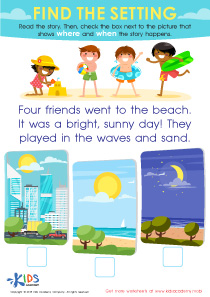Animal recognition Easy Worksheets for Ages 6-7
7 filtered results
-
From - To
Discover our "Animal Recognition Easy Worksheets for Ages 6-7," designed to enhance young learners' understanding of animals through engaging, age-appropriate activities. These worksheets provide a fun way for children to identify, classify, and learn about various animals, fostering their curiosity and love for nature. Each printable activity promotes critical thinking, coordination, and creativity while aligning with early educational standards. Ideal for use at home or in the classroom, these worksheets support skill development in an interactive manner. Help your child explore the animal kingdom with activities that are both entertaining and educational! Perfect for nurturing little minds today!


Australian Animal Subtraction Worksheet


Big Cats and Their Cubs Worksheet


Ordering 11–20: Chicken & Egg Dot–to–dot Worksheet


Name It! Worksheet


Addition at the Zoo Worksheet


Animal Addition Worksheet


Counting Birds Worksheet
Animal recognition is important for children ages 6-7 for several reasons. First, understanding different animals helps children connect with the natural world around them. This connection fosters curiosity and appreciation for wildlife which is essential for nurturing environmental consciousness in future generations.
Secondly, recognizing animals boosts children's observational skills. As they learn to identify various species, they develop better focus and attention to detail. This can translate into improved skills in other subjects, like science and art, where observation is key.
Moreover, learning about animals enhances vocabulary and encourages communication. Children will learn new words related to animals, their habitats, and behaviors, making their language richer and their conversations more engaging.
Additionally, animal recognition often fosters a sense of empathy. Understanding animals’ needs and behaviors can help children relate to other living beings and cultivate compassion. They learn about ecosystems and the role humans play in protecting animals and their environments, which is vital for developing responsible future citizens.
In short, encouraging animal recognition in children is vital to their learning, emotional development, and appreciation of the world, fostering skills that extend far beyond the classroom.
 Assign to My Students
Assign to My Students





.jpg)
.jpg)









